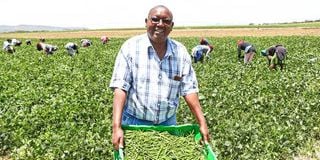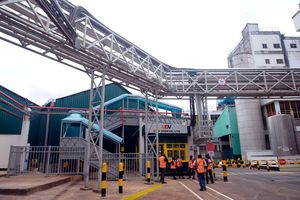Premium
Bjorn Lomborg: A second Green Revolution?

Workers harvest French beans at a farm in Naivasha, Nakuru County.
What you need to know:
- Nobel Peace Prize-winning agronomist Norman Borlaug, who spearheaded the intensification of modern farming methods, is estimated to have saved more than one billion people from hunger.
- The Green Revolution also made societies richer and more efficient as people are freed from backbreaking labour and become more productive.
- Now the world needs a second Green Revolution, as we fall behind on feeding the planet.
One of humanity’s biggest achievements in the past century was hugely increasing food production.
From 1900 to 2000, there was a six-fold increase in crop harvests while the global population increased less than four-fold. We now have around 50 per cent more food than our great-great-grandparents.
Most of the increase in production came from farmers growing more food from each hectare of land, thanks to the Green Revolution that turbo-charged modern inputs for farming.
Nobel Peace Prize-winning agronomist Norman Borlaug, who spearheaded the intensification of modern farming methods, is estimated to have saved more than one billion people from hunger. The Green Revolution also made societies richer and more efficient as people are freed from backbreaking labour and become more productive.
Now the world needs a second Green Revolution, as we fall behind on feeding the planet. Since 2016, world leaders have made grand development promises for 2030, the Sustainable Development Goals (SDGs). One of the most crucial goals is boosting agriculture—from ending hunger to ensuring better nutrition and more sustainable farming.
But we are failing our pledges. A tracker shows that, even based on progress before the Covid-19 pandemic’s disruption, politicians’ food promises will not be met by 2030 but more than 80 years later, in the early 2100s. Indeed, the entire world will be late on all its major commitments.
Halfway mark
We are at the halftime mark for our grand promises but nowhere near halfway. We should focus on the smartest solutions in every area—including agriculture and hunger. Agricultural policies like subsidising fertiliser and increasing irrigation deliver moderate benefits to society but, per shilling invested, the effects are not amazing. But there is one clear opportunity: A big increase in investment in agricultural research and development (R&D).
There is much underspending on agricultural R&D for poorer countries. Big corporations spend most in rich countries, where large-scale farmers have deep pockets. In 2015, a whole 80 per cent of global agricultural R&D funding went to rich and upper-middle-income countries, lower-middle-income countries like Kenya got only 20 per cent and the poorest countries almost nothing.
This unequal R&D investment has been persistent for more than half a century. It is a primary reason why the Green Revolution didn’t help the poorest as much as wealthier countries. Cereal yields in high-income countries almost tripled from 1961 to 2018 but were 50 per cent in low-income countries.
Untapped potential
The untapped potential is huge. Research published this week by Copenhagen Consensus shows the world will only need to spend a small amount more every year to generate vast benefits. The additional cost of R&D this decade is about $5.5 billion annually—a relatively small sum, less even than what Americans spend on ice cream in a year.
That will generate better seeds and high-yield crops that can also better handle weather changes like those from climate change. Creating bigger and more resilient harvests will benefit farmers, and more food will favour consumers with lower prices.
Agricultural R&D is a phenomenal investment because, not only do we make agrarian workers more productive, but we also enable more people to be productive and innovative in other sectors too. It leads to fewer hungry people and a lower cost of food.
Dr Lomborg is the president of the Copenhagen Consensus and Visiting Fellow at Stanford University's Hoover Institution. [email protected]. @BjornLomborg https://lomborg.com.





